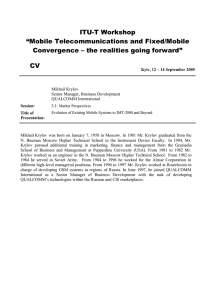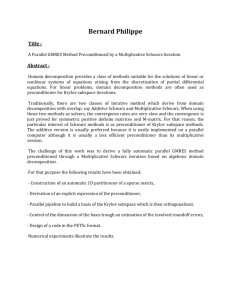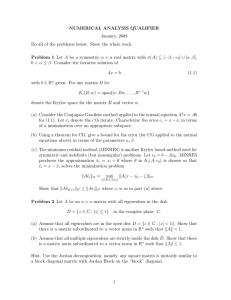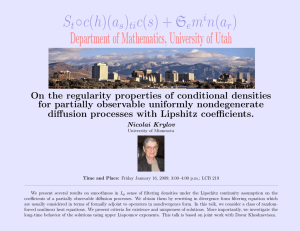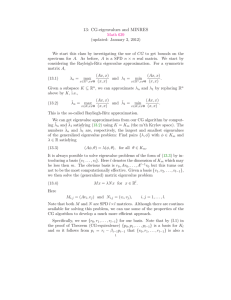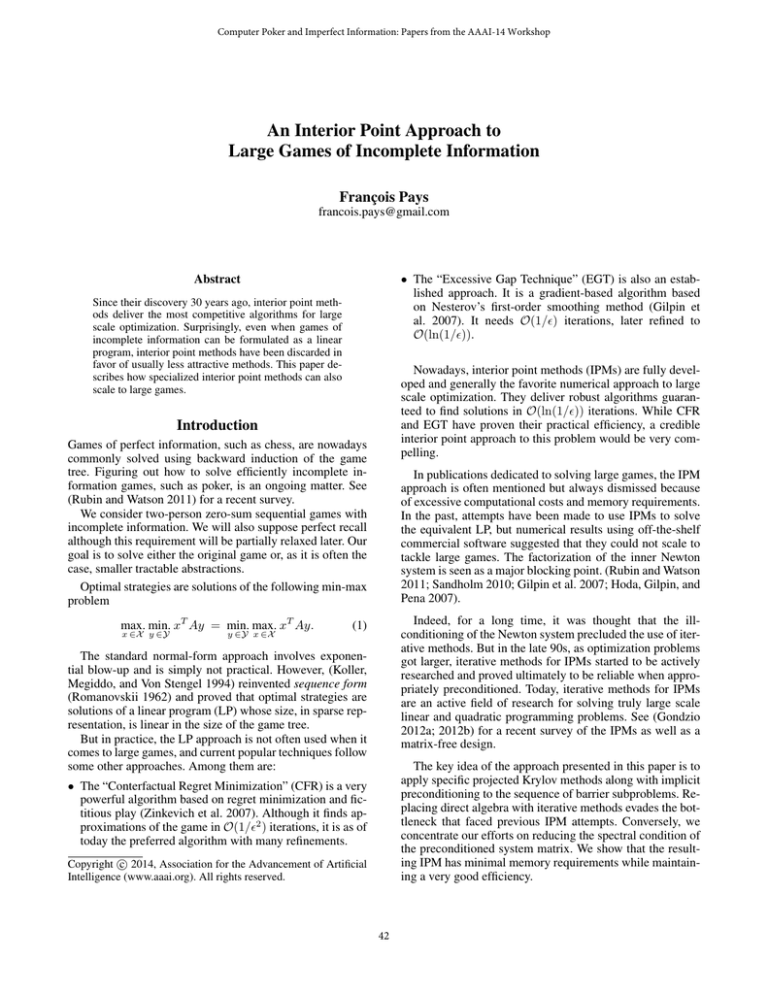
Computer Poker and Imperfect Information: Papers from the AAAI-14 Workshop
An Interior Point Approach to
Large Games of Incomplete Information
François Pays
francois.pays@gmail.com
• The “Excessive Gap Technique” (EGT) is also an established approach. It is a gradient-based algorithm based
on Nesterov’s first-order smoothing method (Gilpin et
al. 2007). It needs O(1/) iterations, later refined to
O(ln(1/)).
Abstract
Since their discovery 30 years ago, interior point methods deliver the most competitive algorithms for large
scale optimization. Surprisingly, even when games of
incomplete information can be formulated as a linear
program, interior point methods have been discarded in
favor of usually less attractive methods. This paper describes how specialized interior point methods can also
scale to large games.
Nowadays, interior point methods (IPMs) are fully developed and generally the favorite numerical approach to large
scale optimization. They deliver robust algorithms guaranteed to find solutions in O(ln(1/)) iterations. While CFR
and EGT have proven their practical efficiency, a credible
interior point approach to this problem would be very compelling.
Introduction
Games of perfect information, such as chess, are nowadays
commonly solved using backward induction of the game
tree. Figuring out how to solve efficiently incomplete information games, such as poker, is an ongoing matter. See
(Rubin and Watson 2011) for a recent survey.
We consider two-person zero-sum sequential games with
incomplete information. We will also suppose perfect recall
although this requirement will be partially relaxed later. Our
goal is to solve either the original game or, as it is often the
case, smaller tractable abstractions.
Optimal strategies are solutions of the following min-max
problem
max. min. xT Ay = min. max. xT Ay.
x ∈X y ∈Y
y ∈Y x ∈X
In publications dedicated to solving large games, the IPM
approach is often mentioned but always dismissed because
of excessive computational costs and memory requirements.
In the past, attempts have been made to use IPMs to solve
the equivalent LP, but numerical results using off-the-shelf
commercial software suggested that they could not scale to
tackle large games. The factorization of the inner Newton
system is seen as a major blocking point. (Rubin and Watson
2011; Sandholm 2010; Gilpin et al. 2007; Hoda, Gilpin, and
Pena 2007).
Indeed, for a long time, it was thought that the illconditioning of the Newton system precluded the use of iterative methods. But in the late 90s, as optimization problems
got larger, iterative methods for IPMs started to be actively
researched and proved ultimately to be reliable when appropriately preconditioned. Today, iterative methods for IPMs
are an active field of research for solving truly large scale
linear and quadratic programming problems. See (Gondzio
2012a; 2012b) for a recent survey of the IPMs as well as a
matrix-free design.
(1)
The standard normal-form approach involves exponential blow-up and is simply not practical. However, (Koller,
Megiddo, and Von Stengel 1994) reinvented sequence form
(Romanovskii 1962) and proved that optimal strategies are
solutions of a linear program (LP) whose size, in sparse representation, is linear in the size of the game tree.
But in practice, the LP approach is not often used when it
comes to large games, and current popular techniques follow
some other approaches. Among them are:
The key idea of the approach presented in this paper is to
apply specific projected Krylov methods along with implicit
preconditioning to the sequence of barrier subproblems. Replacing direct algebra with iterative methods evades the bottleneck that faced previous IPM attempts. Conversely, we
concentrate our efforts on reducing the spectral condition of
the preconditioned system matrix. We show that the resulting IPM has minimal memory requirements while maintaining a very good efficiency.
• The “Conterfactual Regret Minimization” (CFR) is a very
powerful algorithm based on regret minimization and fictitious play (Zinkevich et al. 2007). Although it finds approximations of the game in O(1/2 ) iterations, it is as of
today the preferred algorithm with many refinements.
c 2014, Association for the Advancement of Artificial
Copyright Intelligence (www.aaai.org). All rights reserved.
42
Interior Point Formulation
Az + Js + C T λ
.
r=
Cz − c
ZS1 − σµ1
First Order Conditions
Using the Koller’s notation of a sequence form game (Koller,
Megiddo, and Von Stengel 1994), the Karush-Kuhn-Tucker
(KKT) conditions are
Therefore the Newton equations to derive the search directions are
E T λx + sx + Ay = 0,
F T λy + sy − AT x = 0,
Ex − e = 0, F y − f = 0,
XSx 1 = 0, Y Sy 1 = 0,
x, y, sx , sy ≥ 0.
(4)
A
C
S
(2)
CT
0
0
∆z
J
0 ∆λ = −r.
∆s
Z
(5)
Eliminating ∆s we obtain the augmented system form of the
Newton equations:
• x and y are the searched vectors of realization weights for respective players, of sizes nx and ny .
• A, nx × ny , is the payoff matrix.
A − JΘ
C
CT
0
∆z
= −ra ,
∆λ
(6)
using the notation
• E, mx × nx and F , my × ny , are the full rank constraint matrices with mx < nx and my < ny .
Θ = diag(θ) = Z −1 S = diag(zi−1 si ), i = 1, ..., n.
• λx and λy , of sizes mx and my , are the dual variables.
Observe that (3) is similar to the optimality conditions of
a quadratic programming problem, except that we have the
skew-symmetric −JA in place of a positive-definite Hessian.
Nevertheless, as long as we are able to solve the forthcoming Newton system, nothing prevents us to successfully
make use of the barrier method. See (Boyd and Vandenberghe 2004; Ghosh and Boyd 2003) for the derivation of
the barrier method for convex-concave games.
This is the saddle-point system that we need to solve
efficiently at every interior point step. (Benzi, Golub, and
Liesen 2005) offers a very exhaustive review of existing numerical methods for general saddle-point systems.
Note that, in the quadratic case, we would have −Q −
Θ in the top-left block, which is a much more convenient
negative-definite block. This property would greatly expand
the choice of methods for solving the system, in a variety of
forms.
In our case, A − JΘ is a legitimate cause of concern. Not
only the block is highly indefinite, but it is also increasingly
ill-conditioned as the algorithm converges to the solution.
Since the underlying problem is almost certainly degenerate
(as most of real world problems are), we can anticipate the
condition number of the system to get as large as O(µ−2 )
(Gondzio 2012b), similarly to the quadratic case.
On the bright side, C is full rank and, as we will see later,
has a special structure than we can exploit. Finally, while the
system is very large, it is also very sparse.
Naturally, smaller systems would allow dense direct
methods such as the Gaussian elimination, but on larger
systems, their cubic complexity and memory usage become
quickly prohibitive. On larger systems, the sparse direct algorithms such as the indefinite factorization package MA57
of the HSL library may be contemplated, but yet again, up
to a certain size.
On very large systems, the problem will occupy so much
space in memory, in sparse representation, that it cannot be
modified at all. This is the exclusive domain of indirect, or
iterative methods. Ultimately, in matrix-free regime, the coefficient matrix is not even stored in memory.
Hopefully, our system is eligible to a recent addition to the
arsenal of indirect numerical methods: the projected Krylov
subspace methods combined with appropriate implicit constraint preconditioners.
Newton System
Exact Regularization
Proceeding with the infeasible method (Wright 1997), µ =
zT s
n is the duality measure and σ ∈ [0, 1] is the centering
parameter. The residual is
Prior to introduce the Krylov methods, we need to regularize the system. Regularization is a common and important
safeguard to preserve the conditioning of the system and to
• sx and sy , of sizes nx and ny , are the dual slacks.
• X, Y, Sx , Sy are the diagonal matrices of vectors x, y, sx and
sy .
• I is the identity and 1 is the unit vector.
Let us restates the KKT conditions using
0
AT
A=
Sx
0
X
Z=
0
S=
A
,
0
0
,
Sy
0
,
Y
C=
J=
λ=
E
0
I
0
0
,
−F
0
,
−I
λx
,
λy
e
,
−f
x
,
z=
y
s
s= x ,
sy
c=
with
• s and z are size n = nx + ny ,
• λ is size m = mx + my ,
• A is n × n and C is m × n.
We obtain
JAz + s + JC T λ = 0,
Cz = c,
ZS1 = 0,
Z, S 0.
(3)
43
Examining E: the matrix has as many rows as the first
player has information sets, and as many columns as the
player has choices in the game. An information set is merely
a distinct state of information from a player’s perspective
where he is expected to make a choice. Every row of E has:
protect the convergence of the Krylov solvers. We employ
an exact primal regularization. See (Friedlander and Orban
2012) for details. The actual positive impacts on the convergence of the Krylov methods will be uncovered later.
The regularization parameter γ is a scalar typically in the
range of 10−3 to 10−2 . Our system is modified in the following way:
Θ = Z −1 S + γ 2 I.
• one coefficient −1 corresponding to the move from which
the information originates,
• one or many coefficient 1 corresponding to the moves
made from this information set.
(7)
Notice the exact nature of this regularization: the system
is modified similarly to a Tikhonov’s regularization, but the
residual is left untouched. It implies that we expect to recover an exact (i.e not perturbed) solution of our problem.
However, the regularization has to be carefully performed:
while the regularization benefits to the system conditioning,
it also perturbs the derived search directions. Ultimately, a
constant regularization parameter limits the maximum attainable accuracy of the path-following method. While we
may think of more sophisticated strategies, the simplest of
them is to precompute a suitable parameter value respective
to the target accuracy.
We can immediately observe that, thanks to the regularization, we now have γ 2 < θi .
info sets
1
−1
−1
..
.
E=
0
1
0
0
1
0
0
1
0
|
0
0
1
0
0
1
0
0
1
0
0
0
···
···
···
{z
}
move sets
(10)
Because the game is sequential, the following important property applies: Ek,j = 0 ∀ (i, j, k) such that: j ∈
movesetsi and k < i. Consequently:
Proposition 1. A sequence form constraint matrix E can be
split into [E1 E2 ] where E1 is unit lower triangular using
a column permutation.
Projected Krylov Methods
Construction. For every infoset, we select a move from the
moveset. That is, for every row, we select a column to be
permuted to E1 and we leave the remaining columns to E2 .
This process correctly partitions the column set and leaves
E1 unit lower triangular.
(Keller, Gould, and Wathen 2000) proposed a conjugate
gradient-like algorithm to solve the saddle point system
c
H CT x
=
,
(8)
y
d
C
0
We call Px and Py the permutation matrices such that
where H is positive-definite on the nullspace of C, using a
constraint preconditioner
G CT
G=
,
(9)
C
0
E2 and F Py = F1
EPx = E1
F2 .
It follows immediately that C can also be split into
[C1 C2 ] with C1 J unit lower triangular. P is the corresponding permutation of columns of z such that
where G approximates H and G is easily solved.
The projected preconditioned conjugate gradient (PPCG)
operates on a reduced linear system in the nullspace of C
using any kind of constraint preconditioner. In place of the
constraint preconditioner, (Dollar and Wathen 2004) proposed a class of incomplete factorizations for saddle point
problems, based upon earlier work by Schilders. More recently, (Gould, Orban, and Rees 2013) extended this approach to a broader range of Krylov methods such as
MINRES for possibly indefinite H.
e = CP = C1
C
E1
C2 =
0
0
−F1
E2
0
0
.
−F2
(11)
Schilders’s Factorization
Using the permutation matrix P defined is the previous section, let us split Θ:
e = P T ΘP = Θ1
Θ
0
Constraint Structure
The special structure of C is of importance and need to be
exploited.
In sequence form, strategy probabilities are replaced by
much smaller strategy supports called realization plans.
Each player’s vector (x or y) represents the sequence of realization weights of every choice (or move) at every information set. See (Koller, Megiddo, and Von Stengel 1996) for
details. E and F are the constraint matrices. The equalities
Ex = e and F y = f merely verify that x and y are valid
realization plans with respect to the game.
Θ1x
0
0
=
Θ2
0
0
0
Θ1y
0
0
and the payoff matrix:
PxT APy =
A11
A21
A12
.
A22
Let us split A accordingly:
A11
Ae = P T AP =
AT12
44
A12
.
A22
0
0
Θ2x
0
0
0
,
0
Θ2y
Spectral Analysis
We keep in mind the special 2 × 2 block structure of Ai,j :
A11 =
A12 =
0
AT11
A11
,
0
A12
.
0
0
AT21
0
AT22
A22 =
The convergence of the Krylov methods depends on the
spread of the eigenvalues of the preconditioned system matrix G −1 H. (Keller, Gould, and Wathen 2000) proved that
the similar matrix
A22
,
0
(12)
e
Ge−1 H
T
Let P be the permutation matrix of (z λ ) :
P=
P
0
0
.
I
e u = νN T GN
e u,
N T HN
(18)
e
where N is a nullspace basis for C. Just like (Dollar and
e
Wathen 2004), we use as a nullspace basis for C
Note that, in the permuted space, we conserve the notation
J for a matrix with the same structure, appropriately sized
and partitioned between the ‘x’ and ‘y’ subspaces.
In the P-permuted space, matrix H of system (6) becomes
A11 − JΘ1
e = P HP =
H
AT12
C1
T
That is
e
H
e
H= e
C
with
e = A11 −T JΘ1
H
A12
A12
A22 − JΘ2
C2
C1T
T
C2 .
0
N=
0
Q=0
C1
0
I
C2
0
Ge = QT BQ = 0
C1
That is
e
G
Ge = e
C
eT
C
0
e=
with G
0
DΘ2
0
0
0
Since D is either I of −J, the generalized eigenvalue problem (18) is equivalent to the eigenvalue problem for matrix
D−1 K with
I
0 .
0
T
G = PQ BQP .
e Θ
N T HN
2
−1/2
e Θ
N T AN
2
= Θ2
−1/2
−1/2
− Θ2
−1/2
RT JΘ1 RΘ2
− J.
Recall the 2 × 2 block structure of Aij (12) and observe that
(14)
K=
−Kx
Ks
KsT
= Kdiag + Kof f ,
Ky
(19)
with
Kdiag =
T
C1
C2T .
0
−1/2
−1/2
K = Θ2
(15)
Kof f =
−Kx
0
0
Ks
0
=
Ky
KsT
=
0
−1/2
−J − JΘ2
−1/2
,
−1/2
.
RT Θ1 RΘ2
−1/2
Θ2
e Θ
N T AN
2
Explicitly:
0
.
DΘ2
−1/2
−1/2
= I + Lx ,
−1/2
−1/2
Θ2y RyT Θ1y Ry Θ2y
= I + Ly ,
Kx = I + Θ2x
Ky = I +
e T is never explicitly
Naturally, our preconditioner G = P GP
formed and kept in the factored form
T
.
e = N T AN
e − RT JΘ1 R − JΘ2 ,
N T HN
e = DΘ2 .
N T GN
A12
.
A22 − JΘ2
0
DΘ2
C2
0
F1−1 F2
It follows
The diagonal inversible matrix D will be either I or −J in
the next sections, depending on the Krylov method considered. The preconditioner in the permuted space is
0
−E1−1 E2
=
Ry
0
Rx
R = −C1−1 C2 =
0
eT
C
,
0
I
0
0 and B = 0
0
I
R
,
I
with
(13)
Similarly to (Dollar and Wathen 2004), we consider the following Schilders’s factorization QT BQ where
(17)
has 2m eigenvalues of value 1, and n − m eigenvalues solutions of the generalized eigenvalue problem
T T
Ks =
RxT Θ1x Rx Θ2x
−1/2
Θ2y (RyT AT11 Rx
−1/2
+ AT12 Rx + RyT AT21 + AT22 )Θ2x
.
(16)
Split Choice From a preconditioning viewpoint, we want
to promote the identity in front of Lx , Ly and Ks . Since the
constraints split process leaves a choice of column at every
row, we choose θ2 to contain the largest possible elements
and, conversely, θ1 the smallest. To achieve this goal, we
choose for C1 , at each row i of C, the column
arg max zj−1 sj .
At every interior point step, the matrix C is implicitly split using the construction algorithm. Only the permutation matrices are actually constructed, that is pairs of
one-dimensional array of indices, and no other data structures need to be created. The projected Krylov method requires, from its preconditioner, the solution of a linear system with G and a different right hand side at every Krylov
step. The solution of this linear system is obtained by forward/backward substitution in (16).
Unlike direct methods such as the Cholesky factorization,
the memory requirements of short-recurrence iterative methods are minimal. The only significant memory usage is the
storage of the matrices A, E and F in sparse representation,
or even more condensed formats when available.
j∈moveseti
Naturally, we cannot expect to have all the elements of θ1
smaller than the elements of θ2 . But we expect the geometric
mean of θ1 to be much lower (by an order of magnitude) to
the geometric mean of θ2 .
Let us complete the spectral analysis depending on the
choice for D (either I or −J).
45
Projected MINRES
Convergence Let us examine Ks , Kx and Ky as the IPM
converges to the solution. zi−1 si can have a very wide range
of values: we expect the lowest elements to be o(µ) and
the larger elements to be O(µ−1 ). After the split, we expect
θ2 to contain slightly larger elements than θ1 , in geometric
mean. Finally, recall that θ2 cannot be smaller than γ 2 .
Considering the range of values of θ1 and θ2 , Lx and Ly
perturb the identity only when θ1i is large and θ2j is small
(but never smaller than γ 2 ). Therefore we expect Kx and
Ky to have a large number of eigenvalues into the upper
vicinity of 1, and a smaller set of possibly large (O(µ−1 ))
eigenvalues. Finally, we expect the coefficients of Ks to be
bounded and highly sparse, since they vanish everywhere
except where θ2x and θ2y are not too large.
Consequently, we expect a good conditioning of the preconditioned system and a very large number of eigenvalues
in the vicinity of 1 and −1.
Let us consider the preconditioner when D = I. The preconditioner in the permuted space is
0
Ge = QT BI Q = 0
C1
0
Θ2
C2
C1T
C2T .
0
(20)
e
First and foremost, we observe that N T GN
= Θ2 is
e
positive-definite, thus G is positive-definite on the nullspace
e Consequently we are permitted to use the projected
of C.
version on MINRES (Paige and Saunders 1975) which is
a Krylov subspace method based on Lanczos tridiagonalization for solving symmetric indefinite systems. The projected variant using a constraint preconditioner is analyzed
in (Gould, Orban, and Rees 2013).
Proposition 2. The matrix of the preconditioned system
(17), when D = I, has 2m eigenvalues of value 1, nx − mx
negative and ny − my positive. Any eigenvalue ν satisfies
1 ≤ |ν| ≤ 1 + Ω2
kAk + θ1 max
,
θ2 min
Projected Conjugate Gradient
It is very tempting to consider the preconditioner resulting
from the choice D = −J. Unfortunately, at first sight, the
resulting preconditioner is not applicable to the projected
conjugate gradient.
However, our numerical experiments indicate that CG
preconditioned in this manner, not only works, but significantly outperforms MINRES. These excellent practical results suggest a closer analysis.
The preconditioner in the permuted space is
(21)
where Ω is a constant that depends on E and F .
Proof.
Lower bound The remaining n − m eigenvalues of the
preconditioned system matrix (17) are the eigenvalues of K.
Observe that Lx and Ly are square positive-definite. The
eigenvalue equation is
(K − νI)u =
−(1 + ν)I − Lx
Ks
KsT
(1 − ν)I + Ly
0
Ge = QT B−J Q = 0
C1
0
−JΘ2
C2
C1T
C2T .
0
(22)
u = 0.
The preconditioner central block is an exact replication of
e (13), but is indefinite on the nullspace of
the diagonal of H
e
C.
The remaining n − m eigenvalues of the preconditioned
system matrix (17) are the eigenvalues of
Kx −KsT
0
K = −JK =
.
(23)
Ks
Ky
Suppose |ν| < 1, Lx +(1+ν)I is positive-definite and the
Schur complement (1−ν)I +Ly +KsT (Lx +(1+ν)I)−1 Ks
cannot be singular, since it is positive-definite. Therefore ν
eigenvalue of K implies 1 ≤ |ν|.
Upper bound Since K is symmetric, the spectral radius
equals the 2-norm: ρ(K) = max |νi | = kKk . We obtain
i
Our first observation is that the matrix K 0 is unsymmetric.
It follows immediately that CG is not well defined on the
corresponding system. Indeed, the conjugate gradient will
be unable to build an orthogonal basis (Faber and Manteuffel
1984).
The second observation is that K 0 is (unsymmetric)
positive-definite in the sense that uT K 0 u > 0 for all u 6= 0.
This is not a sufficient condition for the conjugate gradient to be applicable, but this means that no breakdown will
ever happen during the course of the method. Despite K 0
positive-definite, u → uT K 0 u is not a proper inner product
since K 0 is not symmetric.
Examining the numerical range of K 0 (containing all its
eigenvalues), we learn immediately that K 0 is positive stable. Indeed, the eigenvalues of K 0 have real parts in the interval [1, max(kKx k , kKy k)], and imaginary parts in the interval [− kKs k , kKs k].
kAk + θ1 max
kKk ≤ kKdiag k + kKof f k ≤ 1 + kRk
.
θ2 min
2
Considering
the structure
of C, C1 and C2 , kRk ≤
max(E1−1 kE2 k , F1−1 kF2 k) depends marginally on
the choice of the split [C1 C2 ]. We name Ω the constant that
bounds kRk over the worse split. Although we acknowledge
that we cannot practically compute this value, Ω is likely in
the range of kEk and kF k.
Inertia −Kx is negative-definite and has rank nx − mx .
The Schur complement Ky +KsT Kx−1 Ks is positive-definite
and has rank ny −my . Sylvester’s Law of Inertia implies that
K has nx − mx negative eigenvalues and ny − my positive
eigenvalues.
46
Convergence In practice, it is common to run the
Hestenes-Stiefel conjugate gradient to a wide range of systems, some unsymmetric (Rozloznı́k and Simoncini 2002)
or even indefinite (Meurant 2006). The key ingredient to
convergence being the same as in the (symmetric) positivedefinite case: the system matrix must exhibit clustered
eigenvalues along with good conditioning.
Considering our discussion of Ks , Kx and Ky when we
studied the spectral condition of the MINRES system, we
can also expect a very good conditioning of the CG preconditioned system along with a large number of eigenvalues
clustered in the vicinity of 1. But the skew-symmetric part
of the matrix may clearly perturb the convergence of the algorithm in the long term.
case. However we would like to address two particular subjects.
Krylov Method Termination
It is worth mentioning the termination condition to the
Krylov method. Usually, iterative methods are stopped when
a target accuracy is reached or when the method fails to converge. But the exact value of this target accuracy is difficult
to decide beforehand.
In exact precision, Krylov methods would yield to an exact solution in at most the size of the system. In practice,
when appropriately preconditioned, they converge much
faster. In the numerical results section, MINRES needed less
than 2% of this amount to obtain an acceptable solution, and
the conjugate gradient needed less than 0.2%.
Indeed, it is widely known that the IPM does not require
an accurate solution of the Newton equations to converge.
This variation is known as the inexact Newton method. See
for example (Monteiro and ONeal 2003). In practice, when
an iterative method is used to solve the Newton equations,
the required accuracy is merely the accuracy such that the
approximate directions are accurate enough for a new effective IPM step.
The resulting technique is therefore easy to derive. The
Krylov method is iterated without specific target accuracy.
Regularly, the interior point method interrupts the Krylov
solver and runs the line-search method with the current
solver iterate. The line-search checks if any progress is possible using these search directions, and if any, computes the
corresponding step length. The Krylov method is finally terminated when two conditions are verified: the search directions converged, and the step length converged (to a strictly
positive value). This technique gives an easy practical condition to the Krylov termination problem and ensures that no
unnecessary work is performed.
Imperfect Recall Extension
There is a strong incentive to reduce the size of the game
abstraction tree and allow the players to forget about the past
(Waugh et al. 2009). However it is worth noting that (Koller
and Megiddo 1992) proved that such games are NP-hard,
hence out of reach of IPMs.
At some costs, we can force a game with imperfect recall to fit in the sequence form framework: one way is to
allow the information nodes to collapse and merge at given
moments. Sequence form seems to easily adapt to such extension when the forgotten information is anything but the
action history. But there is an obvious catch: while realization weights can still be interpreted as strategy probabilities,
they cease to be well defined. Indeed, the sequence form no
longer represents — at less accurately — the move transitions. Consequently, solutions of the min-max equivalent
problem are no longer genuine equilibria.
Rather than discarding this approach, we decide to regard
it as an another approximation on top of the game abstraction. Hence we expect the solution to exhibit an additional
exploitability, and possibly expect this exploitability to be
compensated by a larger or more accurate abstraction. The
interesting problem of quantifying and possibly bounding
this exploitability is beyond the scope of this paper.
On the interior point side, there is one notable difference
in the constraint structure, but without any consequences.
Information sets will now originate from more than one predeccessor. Since a child node can now originate from all parent nodes with similar action history, the unique negative coefficient in each row of E and F is replaced by a set of negative coefficients (whose sum is −1). But since proposition
1 is still valid, the matrices E and F can be split similarly to
the perfect recall case. Global convergence of both Krylov
methods and interior point method are unaffected.
All the problems of the numerical results in the final section will make use of this imperfect recall extension.
Scalability
The author has successfully run the method described in this
paper to games up to 1.3 109 game states using a single
workstation. The EGT and CFR methods are said to have
successfully solved games with 1012 game states. In order
to reach such orders of magnitudes, an algorithm must display a very high level of scalability both in term of memory
and computing resources. This is key to exploit massively
parallel architectures such as supercomputers.
As already noticed (Gondzio 2012b), for truly large problems, nothing prevents the IPMs to run in matrix-free regime
provided that the newton equations are solved using iterative
methods. Naturally, this supposes that the underlying problem is able to propose an alternative representation of the
payoff and constraint matrices. When dealing with games
like the Texas Hold’em poker, the matrices display some
special characteristics that make them particularly easy to
condense in smaller representations (Sandholm 2010; Gilpin
et al. 2007). Succinctly, since the cards information can be
separated to the action tree, the constraint and payoff matrices can be decomposed in Kronecker products of smaller
matrices.
Implementation
The implementation of the primal-dual path-following infeasible method is a very well documented subject. See
(Wright 1997) in particular, for standard frameworks. The
subjects like starting point, path proximity, path neighborhood, centering are not very different from the quadratic
47
ing only matrix-vector multiplications involving A or AT .
This serves as an estimate of the computational workload
needed to solve the abstraction.
On the computational side, and preconditioning left aside,
the Krylov solvers are essentially dominated by the matrixvector multiplication. The matrices being either the payoff
matrix or the constraint matrices. The preconditioner requires essentially the same operations, with the notable addition of the triangular solve operation of E1 and F1 . The
multiplication parallelization is easy and common in scientific supercomputing, but the triangular solve operation can
be much harder due to its inherent sequential nature. However, we are reasonably optimistic that the special structure
of the constraints could be again exploited in this situation.
M1
M2
M3
M4
Numerical Results
A non-zero
44,688,967
86,150,842
342,718,342
770,330,842
263,316
488,541
975,391
1,462,241
263,485
488,710
975,560
1,462,410
16,087,743
37,962,365
149,534,483
333,230,233
The computations are carried out on a 12-core Xeon midrange workstation with two dedicated GPU (Nvidia GeForce
Titan, 6GB memory and 2880 cores). The interior point
solver only utilizes one CPU core, but dispatches the computations to one or both GPUs concurrently. For memory considerations, M1, M2 and M3 are computed using one GPU.
M4 utilizes two GPUs. The accuracy unit is the milli big
blind per hand (mbb/h).
Accuracy
44,688,967
86,150,842
347,718,342
770,330,842
9h59
12h49
46h05
58h16
286
316
443
476
349,797
315,794
274,113
253,294
22.7
48.0
165.6
337.6
×1012
1e+14
1e+08
1e+09
Game states
Figure 2: Dependence on the game size (M1 to M4)
IPMs have practical and theoretical dependence of
O(ln(1/)) on the required termination accuracy. This
clearly does not hold in our IPM variation since the Newton system has to be parameterized with a target accuracy
and the condition of the preconditioned system still slowly
degrades. Consequently, despite the regularization, the steps
of the IPM require more and more work and slowly decrease
in efficiency. Nevertheless, figure 3 displays a solid convergence even past the target accuracy of 1 mbb/h.
CG
MINRES
101
FLOP
1e+13
1e+07
Our first observation on figure 1 is that CG clearly outperforms MINRES. MINRES is a very solid method, totally
failsafe, with a steadily decreasing residual. The CG residual decreases less steadily, needs more monitoring, but converges considerably faster.
102
Krylov
steps
100
102
10-1
10
1
0.7
100
0.6
10-2
Accuracy
10-3
10-4
10-5
0
0.5
1
1.5
2
2.5
3
Total Krylov iterations
0.5
10-1
0.4
10-2
0.3
10-3
3.5
Krylov total steps (×106)
0.2
-4
10
0.1
-5
10
Figure 1: CG versus MINRES on M1
0.8
0
0.0
100 200 300 400 500 600 700 800 900
Interior point steps
In the table below, the IPM uses CG to solve the abstractions down to 1 mbb/h. The column FLOP is the total number of double-precision floating-point operations consider-
Figure 3: Dependence on accuracy on M1
48
Krylov steps (×106)
A cols
IPM
steps
1e+15
FLOP
M1
M2
M3
M4
A rows
Time
IPM convergence using CG displays solid results. Figure 2 suggests overall linear dependence over the game size
(number of game states). This matches the standard practical
complexity results of IPM (Wright 1997; Gondzio 2012a).
The following games (M1, M2, M3 and M4) are increasingly accurate, and therefore large, abstractions of the Texas
Hold’em limit poker with the imperfect recall extension.
Game states
Game states
Conclusion
Koller, D.; Megiddo, N.; and Von Stengel, B. 1994. Fast
algorithms for finding randomized strategies in game trees.
In Proceedings of the twenty-sixth annual ACM symposium
on Theory of computing, 750–759. ACM.
Koller, D.; Megiddo, N.; and Von Stengel, B. 1996. Efficient
computation of equilibria for extensive two-person games.
Games and Economic Behavior 14(2):247–259.
Meurant, G. 2006. The Lanczos and conjugate gradient algorithms: from theory to finite precision computations, volume 19. SIAM.
Monteiro, R. D., and ONeal, J. W. 2003. Convergence analysis of a long-step primal-dual infeasible interior-point lp
algorithm based on iterative linear solvers. Georgia Institute
of Technology.
Paige, C. C., and Saunders, M. A. 1975. Solution of sparse
indefinite systems of linear equations. SIAM Journal on Numerical Analysis 12(4):617–629.
Romanovskii, I. 1962. Reduction of a game with complete
memory to a matrix game. Soviet Mathematics 3:678–681.
Rozloznı́k, M., and Simoncini, V. 2002. Krylov subspace
methods for saddle point problems with indefinite preconditioning. SIAM journal on matrix analysis and applications
24(2):368–391.
Rubin, J., and Watson, I. 2011. Computer poker: A review.
Artificial Intelligence 175(5):958–987.
Sandholm, T. 2010. The state of solving large incompleteinformation games, and application to poker. AI Magazine
31(4):13–32.
Waugh, K.; Zinkevich, M.; Johanson, M.; Kan, M.; Schnizlein, D.; and Bowling, M. H. 2009. A practical use of
imperfect recall. In SARA.
Wright, S. J. 1997. Primal-dual interior-point methods,
volume 54. Siam.
Zinkevich, M.; Johanson, M.; Bowling, M. H.; and Piccione,
C. 2007. Regret minimization in games with incomplete
information. In NIPS.
We established that interior point methods can indeed solve
very large instances of zero-sum games of incomplete information. We showed how projected Krylov methods, along
with implicit factorization preconditioners, apply to such
problems and have memory requirements linear in the size
of the game.
We examined the spectral condition of two possible preconditioned systems and discussed the convergence of their
corresponding Krylov methods. We demonstrated that the
projected MINRES is theoretically applicable in the first
case, and observed the practical efficiency of the projected
conjugate gradient in the other.
Finally, we introduced an extension of the sequence form
representation for approximating games of imperfect recall.
We presented numerical results confirming the practical efficiency of the whole approach.
References
Benzi, M.; Golub, G. H.; and Liesen, J. 2005. Numerical
solution of saddle point problems. Acta numerica 14:1–137.
Boyd, S. P., and Vandenberghe, L. 2004. Convex optimization. Cambridge university press.
Dollar, H., and Wathen, A. 2004. Incomplete factorization constraint preconditioners for saddle point problems.
Technical report, Technical Report 04/01, Oxford University
Computing Laboratory, Oxford, England.
Faber, V., and Manteuffel, T. 1984. Necessary and sufficient
conditions for the existence of a conjugate gradient method.
SIAM Journal on Numerical Analysis 21(2):352–362.
Friedlander, M. P., and Orban, D. 2012. A primal–dual regularized interior-point method for convex quadratic programs.
Mathematical Programming Computation 4(1):71–107.
Ghosh, A., and Boyd, S. P. 2003. Minimax and convexconcave games.
University lecture notes available at
http://www.stanford.edu/class/ee392o/cvxccv.pdf.
Gilpin, A.; Hoda, S.; Pena, J.; and Sandholm, T. 2007.
Gradient-based algorithms for finding nash equilibria in extensive form games. In Internet and Network Economics.
Springer. 57–69.
Gondzio, J. 2012a. Interior point methods 25 years later. European Journal of Operational Research 218(3):587–601.
Gondzio, J. 2012b. Matrix-free interior point method. Computational Optimization and Applications 51(2):457–480.
Gould, N.; Orban, D.; and Rees, T. 2013. Projected krylov
methods for saddle-point systems. Cahiers du GERAD 23.
Hoda, S.; Gilpin, A.; and Pena, J. 2007. A gradient-based
approach for computing nash equilibria of large sequential
games. Unpublished manuscript available at http://andrew.
cmu. edu/user/shoda/1719. pdf.
Keller, C.; Gould, N. I.; and Wathen, A. J. 2000. Constraint
preconditioning for indefinite linear systems. SIAM Journal
on Matrix Analysis and Applications 21(4):1300–1317.
Koller, D., and Megiddo, N. 1992. The complexity of twoperson zero-sum games in extensive form. Games and economic behavior 4(4):528–552.
49

